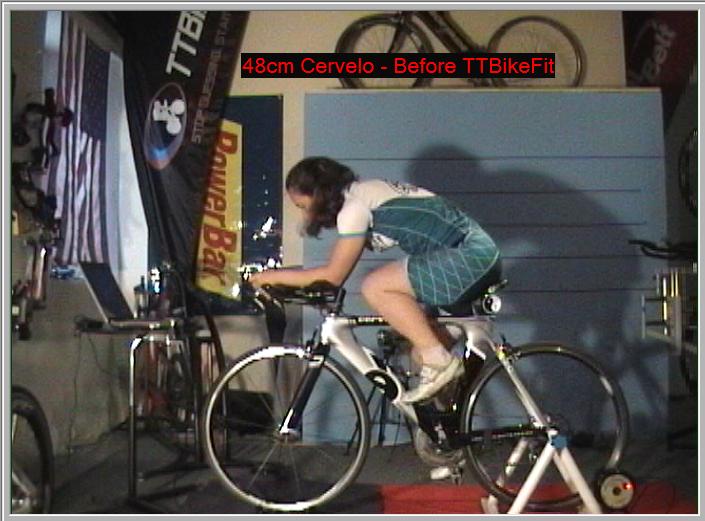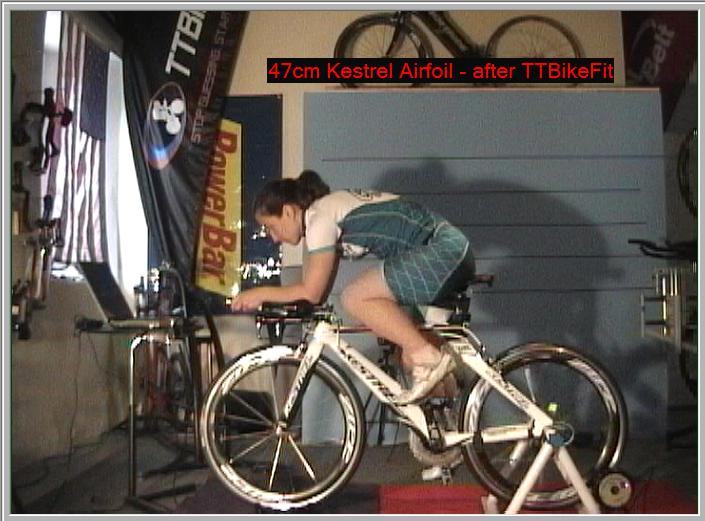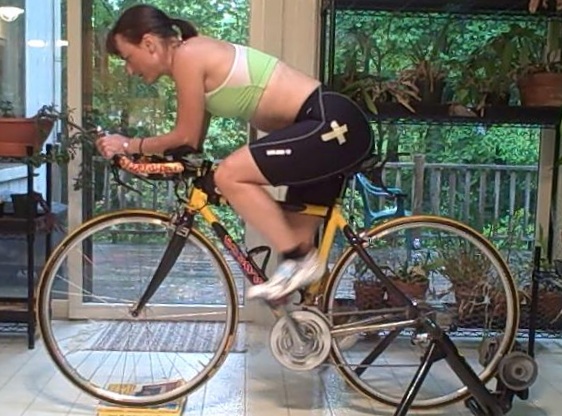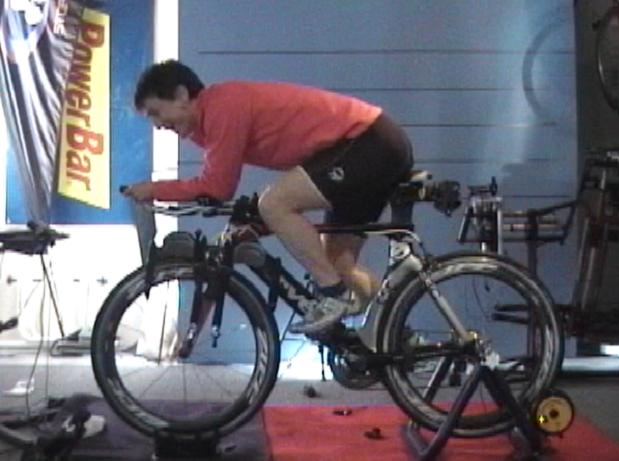Aero Bike Fit for Smaller Riders
Smaller riders can be difficult to fit properly into a good aero position, yet we have achieved good fit results with quite a few riders of smaller stature – those shorter than 5’4″, and especially athletes 5’2″ and under. Aerodynamics are actually quite important for smaller riders, since their absolute power output is relatively small. Hence on a flat road, their lower power means they have a tougher time fighting wind resistance. Sure, they have a smaller frontal area than a big rider (and hence less drag), but the decrease in frontal area is typically not nearly as large as the power decrease. They also tend to be lighter than big riders, and hence their weight doesn’t help them as much when descending. But a decent aero position can go a long way in overcoming these handicaps, so that the smaller rider can get to the bottom of the climb with the big guys – and then really shine with their excellent power/weight ratio.
Smaller riders are frequently sold bikes that are too large for them. Now, too large can take on many forms – but commonly the stack height of the bike it too tall for the rider, making it impossible to achieve an aggressive position. Certainly the reach can be too long as well, but it seems that many of the small frame designs, especially “women’s” bikes, are built way too high in front. This occurs in both road and tri frames. If you use a saddle height of say 60cm, which I see commonly in women of 5’2″ or smaller, you need a low stack frame if you have any designs on getting into an aggressive aero position.
Most of the bigger name tri frames have stack height of around 46-47cm in their smallest sizes. This will limit the amount of drop the a small rider can easily achieve. If we take the 60cm saddle height mentioned above, such a rider would only be able to get about 5-6cm of drop to their aerobar pads – and that assumes low-stack aerobars and a horizontal (-17 degree) stem. Since most bikes are sold with a smaller drop -10 to -6 stem and higher stack bars, this rider often finds that the max achievable drop is 0 to 3 cm. While this may be appropriate for some, it is rarely acceptable for a solid aero position.
It should go without saying here that if you are around 5′ 4″ or less and want to be aero, you should be considering bikes with 650c wheels. It is essentially impossible to build a bike with a stack below about 48 cm or so if it has 700c wheels. Many riders in the 5′ 4″ + range can also fit well on a low-stack 650c frame. In any case a smaller rider should be fit on a fitbike initially so that a particular bike design’s limitations do not restrict their positioning. Once the ideal fit coordinates are found, the fitter should be able to tell you what the max stack height is that will allow that position. Often times the same small rider with short legs has a relatively long torso, so they also need a relatively long reach frame.
The Kestrel Airfoil in 47cm is simply the lowest stack production frame available, and should be on any smaller rider’s list. It is literally the only production bike that will work well for certain athletes. At 43.7cm stack, it is a full 2.4cm+ (1″) lower in front than the 46+cm stack bikes that represent the lowest bikes made by most manufacturers. It also has a very low headset cap, so in effect if it typically 3cm or more lower than many other “smallest” bikes. It will give a 5′ rider the most flexibility in fit, bar choice, etc. Even the saddle height can get lower than most other bikes – down to about 55-56cm from center of BB. The 50cm Airfoil, which also has 650c wheels, provides the longest reach of any bike with a stack below 47cm. So once again, it can be the only good choice for a smaller rider with short legs.
We recently fit a 5′ rider on a 47cm airfoil that had been previously riding a 48cm Cervelo, with a 46cm stack and higher stack aerobars. She had the Cervelo seatpost all the way down and it was barely low enough. We outfitted the Airfoil with a flatter, longer stem than stock, and were able to position her at a steep effective seat angle of 81 degrees thanks to the Airfoil’s adjustable seat post. She went from looking like she should have a flower basket on her aerobars to looking like a pro.


A custom frame can occasionally be the only option for VERY small riders, but beware! I have worked with several custom frame owners and they unfortunately have generally been a disaster. Please make sure the fitter REALLY knows what he is doing, and that he has tri-specific experience. The worst cases often arise from fitters who only know road fit and try to spec a custom tri frame based on road fit parameters. A good example is shown below – this is another approximately 5′ athlete who was told that she MUST have a custom bike. Clearly that was wrong, and the custom fit was terrible. The right stock frame with the right bars worked just fine.


I should also mention that any small rider should be on 165mm (ideally smaller but good luck finding them) cranks. This will allow a higher saddle, less knee and hip compression at the top of the pedal stroke. If we look at an average rider, maybe 5′ 10″ with a 74cm saddle height on 172.5mm cranks, the crank length is 23% of their saddle height. For the rider with the 60cm saddle height on 165 cranks, the crank arm is over 27% of their saddle height, meaning their foot is proportionately higher at the top of the pedal stroke, which results in a tighter hip angle. This would be equivalent to the average rider using a 200 mm crank!! To be equal, the small rider really needs 140mm cranks. So it is also typically important to position a smaller rider with a very steep seat angle to help open the hip angle.
There are things that can be done to your existing bike even if it is higher than ideal in front. Get a level, or even a negative drop stem (25 or 30 degrees). Use low stack aerobars (Vision Tech, Zipp Vuka integrated, 3T Mistral, Oval A900, etc – but also be aware that the reach of each of these bars varies greatly). A good fitter should be able to calculate exactly what you need to achieve the desired fit.
The good news is small athletes CAN get just as good a fit as average ones. And in most cases, they don’t need a custom frame. They do need to obtain good fit coordinates from a fit bike session with a knowledgeable fitter, and then have the proper frame and/or components specified. In all cases this must take into account sufficient drop and reach, as well as hip angle so that the athlete can be aero, powerful, and comfortable.

May 3, 2011 @ 12:35 pm
Hi,
I read your article and its really interesting. I wondered what crank size would you suggest for athletes around 5ft 7inches?
Thanks
Dermot
May 3, 2011 @ 12:38 pm
That depends – as a general statement though, 170 or 172.5